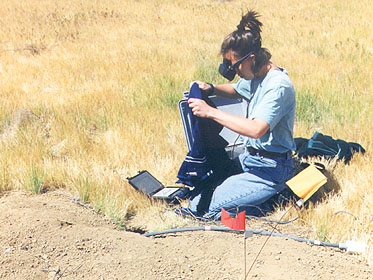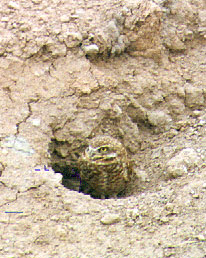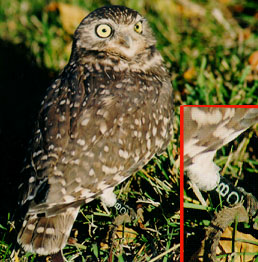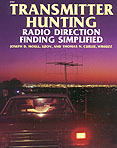History of the Burrowing Owl Monitoring Project
by Joe Moell KØOV
Since 1998, hams and VHF monitoring enthusiasts have been helping to track the movements of endangered Burrowing Owls with their VHF receivers and outside antennas. This page will give you the history of their efforts.
Background
 We've all seen nature shows on TV that feature biologists locating radio-tagged critters with portable direction finding gear. Migrating birds are among the most difficult to study because they travel long distances in short periods, even in weather that is bad enough to prevent following them by aircraft. Transmitter power must be very low to conserve battery life and minimize weight. Researchers have discovered that the hundreds of thousands of Amateur Radio enthusiasts on our continent can aid their efforts.
We've all seen nature shows on TV that feature biologists locating radio-tagged critters with portable direction finding gear. Migrating birds are among the most difficult to study because they travel long distances in short periods, even in weather that is bad enough to prevent following them by aircraft. Transmitter power must be very low to conserve battery life and minimize weight. Researchers have discovered that the hundreds of thousands of Amateur Radio enthusiasts on our continent can aid their efforts.
One important species in these studies has been the Burrowing Owl. In winter months, these unusual creatures can be found in southern USA, from California to Mississippi. In California's Imperial Valley, many of them are permanent residents. They also make homes in Florida from Orlando to the Keys. However, their habitat is diminishing. As a result, they are considered endangered in some places and "of special concern" in others.
Unlike other owls, it's unusual to see a Burrowing Owl in a tree. They prefer to roost in cavities on the ground in treeless grasslands. By day, they stand at a burrow entrance, ready to duck inside when necessary to avoid predators such as hawks. At night, they take flight to feed on small snakes, lizards, and rodents. They fly in an undulating pattern and sometimes hover in the air to catch grasshoppers, beetles and other insects.

Hams' First Effort
Early in March 1998, e-mail arrived from Helen Trefry, a Wildlife Technician with the Canadian Wildlife Service, who was researching th migratory and dispersal habits of Burrowing Owls. "We know so little about their movement," she wrote. "We have no idea how long they take to migrate or if they make long stops along the way. It may be that weather is a large factor in determining the rate of movement."
 Owls banded during the summer in Saskatchewan had previously been recovered in southeastern Colorado and the panhandle of Texas, lending support to the theory that they migrate south through the plains east of the Rockies to spend winter months in southern Texas and nearby regions of northern Mexico. To get more data, Saskatchewan Environment and Resource Management (SERM) conducted a Migration Tracking Project in the fall of 1997. SERM biologists fitted 12 Burrowing Owls with necklace-style VHF transmitters and attempted to follow them south with a Cessna 185 equipped with a telemetry receiver. A ground crew went along to confirm migratory roost locations and to record qualitative habitat information.
Owls banded during the summer in Saskatchewan had previously been recovered in southeastern Colorado and the panhandle of Texas, lending support to the theory that they migrate south through the plains east of the Rockies to spend winter months in southern Texas and nearby regions of northern Mexico. To get more data, Saskatchewan Environment and Resource Management (SERM) conducted a Migration Tracking Project in the fall of 1997. SERM biologists fitted 12 Burrowing Owls with necklace-style VHF transmitters and attempted to follow them south with a Cessna 185 equipped with a telemetry receiver. A ground crew went along to confirm migratory roost locations and to record qualitative habitat information.
SERM used the tags to learn that the birds traveled from 68 to 202 miles nightly during the hours of darkness. In the daytime, they used borrowed badger burrows as avian motels. Bad weather grounded the researchers' small plane (but not the owls!) after a few days. The tag signals were lost in southwestern North Dakota, near Dickinson. They were not heard again until December 1997, when one was picked up by another aircraft 56 miles southwest of San Antonio, Texas. The remains of a banded Saskatchewan owl were discovered by a southern Texas wildlife refuge manager in December 1997.
I agreed to attempt to find some radio amateurs along the flight path to monitor for tag signals during the anticipated northward flight period. It was too late to get the announcement into ham magazines, but I put out the word via Amateur Radio Newsline, the ARRL Letter, the Homing In Web site and Internet mailing lists for transmitter hunters. Dozens responded, representing most of the states in the expected migration path. Hundreds viewed this Burrowing Owl Web page, which gave the tag frequencies and monitoring tips. I have no way of knowing how many ham-hours of monitoring were done, but I know that the response was heartwarming to me and to the researchers. Thank you all.
Somehow, the surviving owls returned to Saskatchewan in late April and early May 1998 without being detected by hams or researchers along the way. Perhaps if more advance notice had been available and more hams had been monitoring, some valuable insights about migration rates and patterns could have been obtained. Helen Trefry asked hams to try again during the owls' southward flights in the fall of 1998. This was also announced in Homing In, the Amateur Radio press, and at this site. Even more hams and scanner enthusiasts were listening this time.
One of the volunteer hams, Grier Garrick KC5FJZ of Rockport, Texas reported a signal on 172.370 MHz on 22 November 1998. A radio collar on that frequency had been attached to a juvenile Burrowing Owl at a farm about 5 miles east of Moose Jaw, Saskatchewan that summer. The Rockport signal disappeared before it could be verified and tracked down. During fall and winter months, "Cactus Charlie" Hoffman K5SBU drove hundreds of miles through the counties south and west of Corpus Christi, Texas, finding four unbanded Burrowing Owls and occasionally picking up radio collar signals. However, he did not find any banded owls from Canada.
In early December 1998, Jason Duxbury, a Canadian graduate student researcher, copied an owl tag from an aircraft west of Kingsville, Texas. He also picked up an owl tag signal from the air over Tamaulipas, Mexico, but neither owl could be located on the ground. New Burrowing Owl habitats were discovered by the Saskatchewan researchers in Texas and Mexico during an expedition in February 1999, but none of these owls had Canadian radio tags or leg bands. It is unknown if the newly-documented Texas and Mexico owls are permanent residents or if they migrate in and out of these places.
Winter/Spring 1999/2000 --- Getting Closer
On 5 October 1999, radio amateur Peter Vekinis KC1QF monitored the 172 MHz band from an aircraft over portions of Arizona, New Mexico and Colorado. He reported a signal on 172.294 MHz near Interstate 10 southeast of Tucson, copyable for about five miles of his travel. This signal was not confirmed on the ground.
On 11 October 1999, Robert Lentz K5BL reported a signal on 172.029 MHz at his home near McKinney, Texas, which is about 33 miles NNE of downtown Dallas. The signal was audible for several hours, but was not tracked down.
On the morning of 27 December 1999, James Kaelin K5DXM received weak periodic signals on 172.029 MHz in Lavaca, Arkansas, 14 miles east of Fort Smith. His beam indicated northward direction. The signals disappeared after two days. Based on these reports, the winter monitoring area was increased to include all southern states from California (Imperial Valley and points east) through Arkansas and Louisiana.

Winter/Spring 2000/01 --- Success!
Many radio amateurs and scanner enthusiasts monitored for migrating Burrowing Owls during fall 2000 and continued to monitor through the winter months. Canadian biologists performed airborne monitoring over southeast Texas, with success. This report was received 6 December 2000 from Geoff Holroyd and Helen Trefry:
"Today we confirmed a Saskatchewan burrowing owl in Texas!
The owl is wearing a transmitter with frequency 172.452 MHz and is near the
tip of Smith Point, on the east shore of Galveston Bay, southeast of Houston
and northeast of Galveston. The owl was banded by Danielle Todd, who attached
a necklace transmitter on the female owl near Milestone, Saskatchewan in
July 2000.
"We located the owl three days ago from the air but could not locate it the
following day on the ground, even though we were in the same area as where
we found it today. Helen Trefry located the owl again yesterday from the air
at the same location where we found it this evening. The owl was roosting
under a large bunch of grass in a recently burned cattle pasture adjacent
to a wooded area that has summer cottages adjacent to the Bay. ...
"This is the first confirmed Canadian owl with a transmitter that has been
located in Texas, and only the second confirmed winter record of a Canadian
owl; the first was near McAllen, Texas in 1998. We have had three
other transmitter signals located in Texas and Tamaulipus, but were never
able to find the owls. Jason Duxbury heard the signals from the air that
were identical as those placed on owls from Saskatchewan. In fact all five
winter records are from owls tagged in Saskatchewan. There has never been an
Alberta banded recovered south of Canada!"
Later in the winter, Geoff Holroyd and Helen Trefry flew in a Cessna 172 over Mexico and received tag transmitter signals. They returned by vehicle and tracked down two owls. Here is their brief report, received 16 February 2001:
"We have finally found Canadian Burrowing Owls in Mexico! Two to be exact!
One was in northern Veracruz state. The transmitter was attached to a
juvenile owl in southern Saskatchewan by Danielle Todd. We found the
transmitter on the ground under an orange tree in an orange grove on the
side of a small volcanic hill. The ground was littered with owl feathers
indicating that it had been plucked by am avian predator. To the north and
east were small pastures, but most of the area is orange groves with small
patches of banana plantations.
"The second transmitter was in northern Michoacan, just south of Guanajuato
state. This transmitter was happily sitting on the back of a live owl that
was banded in southern Alberta by Darcey Shyry. The owl was banded as an
adult male. This owl was in a patch of cactus-thorn shrub on a hillside
surrounded by corn fields and pasture. This owl represents the first
recovery of a Burrowing Owl from Alberta."
Click here for Geoff's full report on the Burrowing Owl discovery in Mexico
Meanwhile, Jerry Batey, a graduate student in the Corpus Christi area, initiated a 2-year study to trap, band, and place transmitters on over-wintering owls in the southeast Texas area. In 2002, a graduate student began a similar study in the central grasslands of Mexico. Do the Texas owls go to Canada in the spring? That's what researchers hope to find out.
Fall 2001 --- Washington Owls Added
The first report on fall migration of Canadian owls was received 24 September 2001 from Helen Trefry:
"Only a few owls were radio-tagged this summer, part of a
study by Danielle Todd in Moose Jaw to examine mortality differences between
released captive-bred young and wild young.
"Our plan for this winter is to continue with the studies on wintering owls
in Texas and Mexico with graduate students and work with USGS as they
install and monitor artificial burrows that we hope the owls will be
attracted to. Since many of the owls in Texas are using artificial burrows
to roost in during the day, we felt there was a need to supply more
structures. One student in Texas and one student in Mexico will be placing
transmitters on the owls they trap, but these numbers will probably be small.
"Although we have learned where some of the owls are wintering, we hope to
learn more through isotopes in the feathers and will continue to collect
feathers in the winter for this study by grad student Jason Duxbury. We
will also ask people to continue searching for banded owls."
On 28 September 2001, e-mail arrived from Vicki Garcia of the College of Agriculture and Life Sciences at University of Arizona. She write to ask for help in tracking 30 juvenile Burrowing Owls that were radio-tagged that summer near Moses Lake in eastern Washington state (100 miles SW of Spokane). She wrote:
"I placed radio collars on 30 juvenile Burrowing Owls in Washington this summer. We don't really know where they travel through or where they overwinter. Certainly they should migrate through Oregon, perhaps Idaho, Nevada, Utah, and California. We think they overwinter in California, Arizona, New Mexico, and Mexico. Baja California is a possibility, but also northern Mexico, maybe even Texas. We believe that they wouldn't cross the Rockies, but the fact is we don't know how far they go nor really where they spend the winter, so it's guesswork. In fact, if anyone did pick up a tag, that would provide us with very valuable information about their migration.
Burrowing Owls in Washington are listed as a Species of Special Concern. They are disappearing from the northern part of their range there. Part of what we're trying to find out is why that's happening. We're also looking at how their burrows affect their survival, offspring number, dispersal of the juveniles, and other aspects that may account for their declining numbers. There's very little information about their migration route or where they overwinter, and there may be something there that helps to account for the decline."
Fall 2002 --- Washington Owls Only
On August 27 2002, Helen Trefry of Environment Canada wrote:
"There will not be any burrowing owls leaving the Canadian prairies with
transmitters this fall, although we will continue with the winter telemetry
work Mexico. An artificial burrow project in south Texas proved successful
last winter- three owls used the artificial burrows for at least a short
time. The telemetry work in Texas and Mexico gave us insight into the
foraging habits of the owls.
"This past summer we tested a roadside technique out further to survey for
owls using a playback call of an owl at 800m intervals. We conducted the
surveys across large tracts of grasslands in Alberta and Saskatchewan. We
also re-checked the nests found for productivity. Many of the nests failed.
There were heavy rains in the southern part of Canada and a 3-year running
drought in central portions of the prairies -- one extreme or the other!
Thanks for your continued interest."
On 11 September 2002, Vicki Garcia of the College of Agriculture and Life Sciences at University of Arizona wrote:
"We'd like to thank all the volunteer monitors who participated last year.
This year, we put out about 85 transmitters and have been tracking the owls
until they leave the study area.
"We still have very little new information about migration. We did get one
band return in the San Francisco area from an owl that was banded at a
nearby study area. We also got one band return in Montana from an owl banded
at the same study area. It may be possible that migration routes
exist both to the southeast and southwest of the owls' original site (Grant
and Adams counties in eastern Washington). Therefore, we could potentially
find migrants from our study area in any state west of the Rockies.
"Thanks again to all the volunteers."
Attention Birders --- Watch for Banded Burrowing Owls
Please inform your local birdwatching organizations
 About 200 Canadian Burrowing Owls (including the above-mentioned ones with radio tags) have been fitted with leg bands for identification. Bands are red, orange, blue, black, green and red-over-green, with an alphanumeric code. In addition, there is an aluminum Fish and Wildlife band.
About 200 Canadian Burrowing Owls (including the above-mentioned ones with radio tags) have been fitted with leg bands for identification. Bands are red, orange, blue, black, green and red-over-green, with an alphanumeric code. In addition, there is an aluminum Fish and Wildlife band.
Burrowing Owls have also been trapped and banded in Texas. These bands are black-over-green. The photo at right shows a Burrowing Owl with black leg band. Wintering Burrowing Owls tend to roost during the day in artificial "burrows" such as pipes, culverts, and rock/concrete piles in both rural and urban situations. They may stand near the entrance of their "burrow" during the day and fly a short distance if disturbed.
If you spot a Burrowing Owl, please observe closely with binoculars to determine if it is banded, plus the band color(s) and band number, if possible. Transmitters are of two styles, necklace and back-pack, and are visible with careful observation.
Reports of Canadian-banded Burrowing Owls, living or dead, should be made to Helen Trefry, Canadian Wildlife Service, Room 200, 4999-98 Avenue, Edmonton, Alberta T6B 2X3, Canada, phone 780-951-8693. Send e-mail reports to k0ov@homingin.com
For more information about the plight of the Burrowing Owl, see Environment Canada Web site. More facts about this species are at The Owl Pages and Owling.com.
Other Bird Projects Need Volunteers
Many hams outside the migration range of the Saskatchewan and Washington owls have written to ask how they can participate in similar research projects. Following publication of our volunteer monitoring capabilities, several other researchers have indicated interest, leading first to a study of Saw-whet Owls leaving Pennsylvania. Volunteers were then requested for studies of Great Horned Owls, Mexican Long-nose Bats, American Woodcock, Sandhill Cranes and Indiana Bats. Current and upcoming projects are detailed in the Wildlife Trackers Needed page of this site. Many thanks to all who have equipped their monitoring posts and spent time tuning the tag frequencies.
 Join the Bio-Trackers Mailing List
Join the Bio-Trackers Mailing List
An e-mail discussion group (i.e. mailing list, reflector) on Yahoo Groups is now coordinating the activities of volunteer monitors on these projects. Owl-heard reports and other late-breaking news are disseminated there, along with updated equipment comments. To join, send e-mail to biotrackers-subscribe@yahoogroups.com. The subject line and text are ignored. To prevent spam, all new subscriptions must be approved by the Moderator.
Copyright © 1998, 2003, 2008 Joseph D. Moell. All rights reserved. The owl image at top of page is courtesy of Saskatchewan Operation Burrowing Owl. The researcher using infrared TV equipment to check hatchlings in an owl burrow is Jennifer Gervais from the Department of Fish & Wildlife at Oregon State University, photographed by Joe Moell in the Carrizzo Plain of central California.
 Go to the Saw-Whet Owl Project page at this site
Go to the Saw-Whet Owl Project page at this site
Go to the The Indiana Bat Project page at this site
Go to the Frequently Asked Questions About Wildlife Tracking page at this site
Go to the Was That Really A Wildlife Tag? page at this site
Back to the Wildlife Trackers Needed page at this site
Back to the Homing In Radio Direction Finding home page
Back to the Hospital Disaster Support Communications System (ARES) home page
 This page updated 22 October 2008
This page updated 22 October 2008
 We've all seen nature shows on TV that feature biologists locating radio-tagged critters with portable direction finding gear. Migrating birds are among the most difficult to study because they travel long distances in short periods, even in weather that is bad enough to prevent following them by aircraft. Transmitter power must be very low to conserve battery life and minimize weight. Researchers have discovered that the hundreds of thousands of Amateur Radio enthusiasts on our continent can aid their efforts.
We've all seen nature shows on TV that feature biologists locating radio-tagged critters with portable direction finding gear. Migrating birds are among the most difficult to study because they travel long distances in short periods, even in weather that is bad enough to prevent following them by aircraft. Transmitter power must be very low to conserve battery life and minimize weight. Researchers have discovered that the hundreds of thousands of Amateur Radio enthusiasts on our continent can aid their efforts.

 Owls banded during the summer in Saskatchewan had previously been recovered in southeastern Colorado and the panhandle of Texas, lending support to the theory that they migrate south through the plains east of the Rockies to spend winter months in southern Texas and nearby regions of northern Mexico. To get more data, Saskatchewan Environment and Resource Management (SERM) conducted a Migration Tracking Project in the fall of 1997. SERM biologists fitted 12 Burrowing Owls with necklace-style VHF transmitters and attempted to follow them south with a Cessna 185 equipped with a telemetry receiver. A ground crew went along to confirm migratory roost locations and to record qualitative habitat information.
Owls banded during the summer in Saskatchewan had previously been recovered in southeastern Colorado and the panhandle of Texas, lending support to the theory that they migrate south through the plains east of the Rockies to spend winter months in southern Texas and nearby regions of northern Mexico. To get more data, Saskatchewan Environment and Resource Management (SERM) conducted a Migration Tracking Project in the fall of 1997. SERM biologists fitted 12 Burrowing Owls with necklace-style VHF transmitters and attempted to follow them south with a Cessna 185 equipped with a telemetry receiver. A ground crew went along to confirm migratory roost locations and to record qualitative habitat information.

 About 200 Canadian Burrowing Owls (including the above-mentioned ones with radio tags) have been fitted with leg bands for identification. Bands are red, orange, blue, black, green and red-over-green, with an alphanumeric code. In addition, there is an aluminum Fish and Wildlife band.
About 200 Canadian Burrowing Owls (including the above-mentioned ones with radio tags) have been fitted with leg bands for identification. Bands are red, orange, blue, black, green and red-over-green, with an alphanumeric code. In addition, there is an aluminum Fish and Wildlife band.

